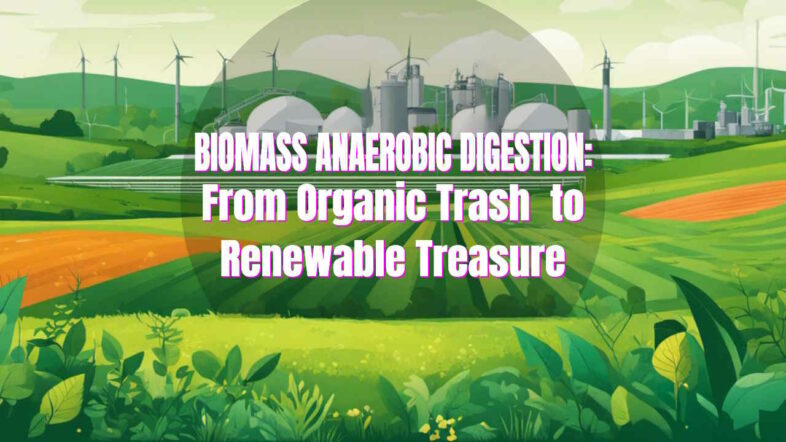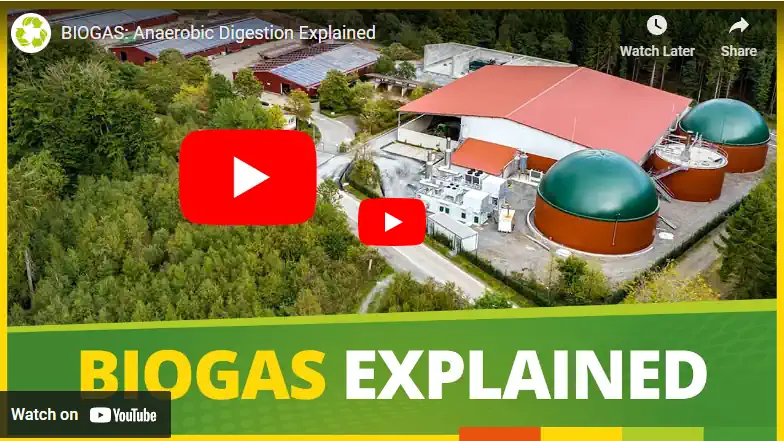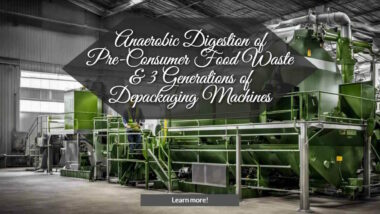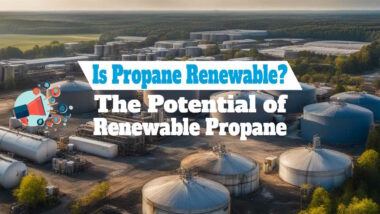Biomass anaerobic digestion is all about turning organic waste into renewable treasure, an optimist would say, but you might equally describe it as recycling dead matter into usable energy.
But however you describe it, developing renewable energy sources is becoming not only a necessity for our planet's future but also an economic necessity, with oil and gas prices staying obstinately high in the autumn of 2023.
With OPEC limiting oil production and the real costs of non-renewable energy exceeding the renewable alternatives, one promising solution lies in biomass anaerobic digestion, a process that converts organic waste into bioenergy.
This article will guide you through the intricacies of this eco-friendly method, shedding light on its benefits and challenges, and recent advancements. Intrigued? Let's dig deeper into the world of biomass!
[boomdevs_toc]
Key Takeaways
- Biomass anaerobic digestion is a process that converts organic waste into bioenergy, helping to explore renewable energy sources.
- Anaerobic digestion involves bacteria breaking down organic materials in the absence of oxygen, producing biogas as a result.
- Mesophilic digestion occurs at 25 to 35°C and produces biogas from biomass like food waste and manure. Thermophilic digestion generates even more biogas by using high heat to break down organic materials.
- The advantages of biomass energy and anaerobic digestion include reducing pollution, offering commercial benefits such as selling biogas and nutrient-rich compost and fulfilling the growing demand for alternative energy sources.
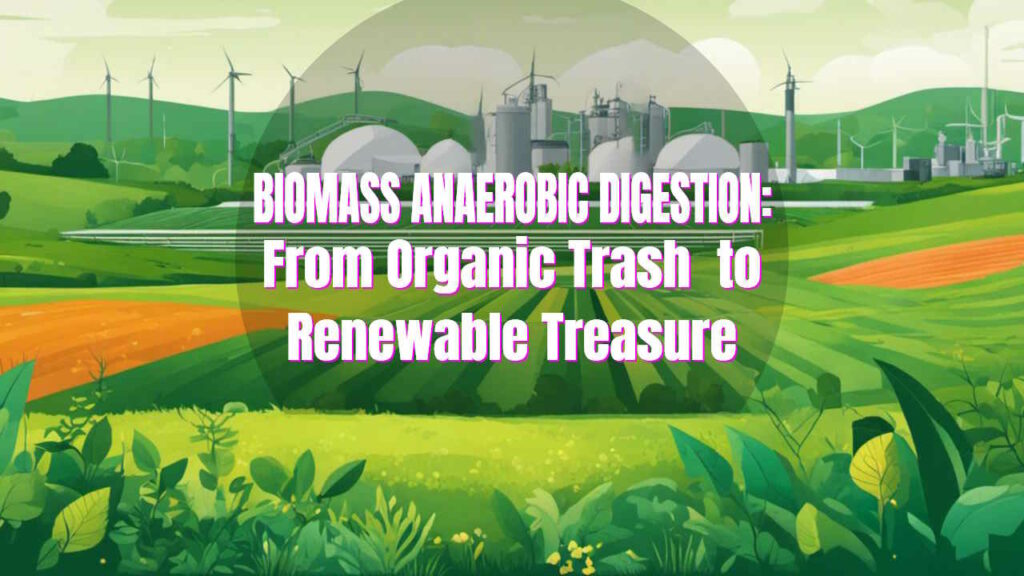
Understanding the Process of Anaerobic Digestion
Anaerobic digestion is a natural process where bacteria biodegrade organic materials in the absence of oxygen (O2), producing biogas as a result.
Mesophilic Digestion
In mesophilic digestion, bacteria work at a cozy 25-35°C. They live in an airless box called a digester. Here, they eat biomass—stuff like food waste and manure. As they munch away, they give off biogas.
This gas has methane and carbon dioxide in it along with other gases. The best part? We can use this biogas for heat or to make electricity!
Thermophilic Digestion
Thermophilic digestion is a big step in turning waste into energy. This kind of digestion happens at high temperatures. You feed bacteria organic materials like plant or animal waste. These bacteria love the hot weather and start to work right away!
They break down the organic materials without any need for oxygen. The end result of their hard work is biogas. Biogas is mostly made up of methane gas but also has carbon dioxide and other gases in it.
This thermophilic process gives us more biogas than its cooler cousin, mesophilic digestion.
The heat also kills bad germs, making everything safer to handle later on! In short, thanks to thermophilic digestion, we get safe and useful energy from everyday waste items.
Thermophilic anaerobic digestion operates at higher temperatures than its mesophilic counterpart. The temperature range for thermophilic anaerobic digestion typically falls between 50°C (122°F) and 60°C (140°F). Within this range, the microorganisms, or thermophiles, are active and can effectively break down biomass to produce biogas.
However, the thermophilic process may require more energy input to maintain the higher temperatures and can be more sensitive to changes in operating conditions compared to mesophilic systems.
Advantages of Biomass Energy and Anaerobic Digestion
Biomass energy and anaerobic digestion have several advantages. They contribute to the reduction of pollution, offer commercial benefits, and fulfill the growing demand for alternative energy sources.
Reduction of Pollution
Digesting biomass, instead of burning it for heat helps cut down on pollution.
This is because the anaerobic digestion (AD) process plus subsequent burning of the biogas gives off less carbon dioxide than gas or coal. AD will play a part in the UK's renewable energy mix, making up about 15% of it.
Biogas (biomethane) burners can even be used in places where there is control over smoke levels. Less pollution means cleaner air for us all to breathe. Using biomass power also reduces the need for landfills and waste-burning sites.
These often give off harmful gases that hurt our health and dirty our planet.
Commercial Benefits
Using biomass and anaerobic digestion offers a lot of business gains. The sale of biogas, especially when that biogas has been upgraded can bring in a good profit. It can replace fossil fuels as heat and power sources and fuel cars and heavy goods vehicles. This cuts energy costs for companies.
Also, the leftovers from the process become nutrient-rich compost. This is another product that they can sell to farmers or gardeners. They make money and help create renewable natural gas (RNG) at the same time! These profits plus government aid make it worth investing in this green energy process.
Demand for Alternative Energy Sources
People around the world want cleaner energy. They don't like things that hurt our Earth, like gas or coal. This is why they are asking for different ways to make energy. Biomass energy and anaerobic digestion can help.
These methods use waste stuff like food scraps and animal poop to create biogas.
This need for new power sources is high in big companies too. Many firms want to pick green ways to do things so they won't harm our planet anymore. Using biomass systems could be one answer for them because it does not pollute nearly as much as fossil fuels do.
Disadvantages and Challenges of Biomass Energy from Burning and Anaerobic Digestion
Biomass energy and anaerobic digestion come with some issues. First, these systems can require a lot of space if the feedstock is to be solely fed on waste generated on the farm. This makes it tough for areas and businesses that do not have much land to spare.
Biomass Boilers
You need an exemption from Defra, which takes time and effort. Then there's the cost factor; they're not cheap to set up or run! The payback period can be between five and twelve years for a biomass combustion system, often even longer than for an anaerobic digestion plant.
On top of this, keeping an eye on what goes into these systems is key because not all waste is good for them. For instance, organic pulp which still has pieces of plastic in it cannot go in because:
- the plastic can get stuck in the digester harming the process of making biogas
- and if any plastic is spread on the land with the fertilizer it will get into rivers and harm the wild life.
Leftover Solid Waste from Anaerobic Digestion
The last issue to think about is the leftover solid waste from anaerobic digestion – digestate – which we use as compost but only if it has no nasty stuff like pathogens in it or else it poses a risk when used on crops or plants.
In short, while biomass energy and anaerobic digestion are great tools against climate change their use comes with many challenges that we have yet to fully solve.
Recent Developments and Future Prospects in Biomass Anaerobic Digestion

New methods to make biomass anaerobic digestion better are being made. One of the most popular methods so far is single-stage anaerobic digestion (SSAD). SSAD works well for things that are easy to break down, like food waste and crop waste. Wood chips need a more sophisticated digester design and are probably best to be burned, not digested, using the current early stage of development of AD technology.
It helps produce more biogas while cutting down on the amount of waste.
The future looks bright for this field. Many believe that soon, power plants will be able to use the heat from biomass anaerobic digestion along with other energy sources. This can lead to even more efficient energy-making processes.
So, we could rely less on resources that harm our planet. In this way, biomass anaerobic digestion stands as a promising solution for a sustainable future.
Biomass Anaerobic Digestion – Conclusion
Biomass anaerobic digestion turns waste into power. It uses tiny living things to break down plant and animal waste without air. This makes biogas, a type of fuel we can use in place of oil or coal.
So, this process not only helps us manage waste but also gives us green energy for our daily needs!
FAQs
1. What is Biomass Anaerobic Digestion?
Biomass anaerobic digestion breaks down biowaste and animal manure in digesters to make biogas. This process can also work with high solid and dry content.
2. What kind of gases does this process produce?
When organic matter like crop residues decompose, they make methane (CH4), carbon dioxide (CO2), and a bit of hydrogen sulfide (H2S), along with water vapor.
3. Can Biogas be used for energy?
Yes, using biomass residues or municipal solid waste can improve global warming problems. The biogas produced can serve as an energy source for combined heat and power plants or the natural gas grid.
4. Is there any other use for the products from anaerobic digestion?
The leftovers after making biogas act as organic fertilizers which boost soil structure and fight desertification. This makes them great for enhancing the sustainability of agriculture while cutting down greenhouse gas emissions.
5. Are there any special methods used in Biomass Anaerobic Digestion?
There are several methods such as Co-Digestion, RSD (Renergon Simultaneous Digestion), Two-phase digestion, etc., based on feedstocks utilized like fruit vegetable wastes & marine biomass;
6. Is it possible to decarbonize transportation through this method?
Yes! By refining raw biogas into bio-methane, we create a cleaner energy alternative that supports efforts to decarbonize transportation systems.
Source URLs:
https://www.netregs.org.uk/environmental-topics/carbon-reduction-and-efficiency/generate-renewable-energy/biomass-and-anaerobic-digestion/
https://www.esru.strath.ac.uk/eande/web_sites/03-04/biomass/background%20info8.html
https://www.sciencedirect.com/science/article/pii/s0961953497000202



